Monitoring the Structural Health of Glass Fibre-Reinforced Hybrid Laminates Using Novel Piezoceramic Film
Abstract
1. Introduction
2. Materials and Methods
2.1. Materials and Specimen Preparation
- an aluminium sheet (EN AW-6082 T4)
- a piezo-active sensor layer
- a reinforcement layer of glass fibre-reinforced plastics (GFRP)
- aluminium-based fibre metal laminate with PZT/PP film sensor layer and glass fibre epoxy reinforcement (PFML-PZT-EP)
- aluminium-based fibre metal laminate with PZT/PP film sensor layer and glass fibre polypropylene reinforcement (PFML-PZT-PP)
- aluminium-based fibre metal laminate with PVDF film sensor and glass fibre epoxy reinforcement (PFML-PVDF-EP)
- aluminium sheet with PZT/PP film sensor layer, but without fibre-reinforcement as reference specimen for static mechanical testing (AL-PZT)
2.2. Experimental Procedure
2.3. Data Recording
2.4. Signal Characteristics
3. Results
3.1. Static Three-Point Bending
3.1.1. Mechanical Characteristics
3.1.2. Signal Characteristics
Complete Failure Analysis Results
Characteristic Trend Formation Analysis Results
Complete Failure Type Analysis Results
3.2. Dynamic Three-Point Bending
3.2.1. Mechanical Characteristics
3.2.2. Signal Characteristic
Complete Failure Analysis Results
Characteristic Trend Formation Analysis Results
Complete Failure Type Analysis Results
4. Discussion
4.1. Detection of Complete Failure
4.2. Characteristic Trend Formation
4.2.1. Static Test Scenario
4.2.2. Dynamic Test Scenario
4.3. Damage Index Analysis
5. Conclusions and Future Work
Author Contributions
Funding
Acknowledgments
Conflicts of Interest
Abbreviations
| AL-PZT | Aluminium sheet with PZT/PP film sensor layer |
| CNT | Carbon Nanotubes |
| CWT | Continuous Wavelet Transform |
| EP | Epoxy Resin |
| FBG | Fibre Bragg Grating |
| FML | Fibre Metal Laminates |
| GFRP | Glass Fibre-Reinforced Plastic |
| MMD | Multi-material Design |
| NDT | Non-destructive Testing |
| PFML | Piezo-active Fibre Metal Laminate |
| PFML-PVDF-EP | aluminium-based PFML with PVDF foil sensor layer and glass fibre epoxy reinforcement |
| PFML-PZT-EP | aluminium-based PFML with PZT/PP foil sensor layer and glass fibre epoxy reinforcement |
| PFML-PZT-PP | aluminium-based PFML with PZT/PP foil sensor layer and glass fibre polypropylene reinforcement |
| PP | Polypropylene |
| PVDF | Polyvinlyliden Fluoride |
| PZT | Lead Zirconate Titanate |
| SED | Spectral Energy Density |
| SHM | Structural Health Monitoring |
References
- Heimbs, S.; Bergmann, T.; Schueler, D.; Toso-Pentecote, N. High velocity impact on preloaded composite plates. Compos. Struct. 2014, 111, 158–168. [Google Scholar] [CrossRef]
- García-Martín, J.; Gómez-Gil, J.; Vázquez-Sánchez, E. Non-destructive techniques based on eddy current testing. Sensors 2011, 11, 2525–2565. [Google Scholar] [CrossRef] [PubMed]
- Cramer, K. Current and future needs and research for composite materials NDE. In Proceedings Volume 10596, Behavior and Mechanics of Multifunctional Materials and Composites XII; SPIE Proceedings: San Diego, CA, USA, 2018. [Google Scholar] [CrossRef]
- Francis, D.; Tatam, R.; Groves, R. Shearography technology and applications: A review. Meas. Sci. Technol. 2010, 21, 102001. [Google Scholar] [CrossRef]
- Gholizadeh, S. A review of non-destructive testing methods of composite materials. Procedia Struct. Integr. 2016, 1, 50–57. [Google Scholar] [CrossRef]
- Giurgiutiu, V. 16–Structural health monitoring (SHM) of aerospace composites. In Polymer Composites in the Aerospace Industry; Woodhead Publishing: Cambridge, UK, 2015; pp. 449–507. [Google Scholar] [CrossRef]
- Kappel, E.; Prussak, R.; Wiedemann, J. On a simultaneous use of fiber-Bragg-gratings and strain-gages to determine the stress-free temperature Tsf during GLARE manufacturing. Compos. Struct. 2019, 227. [Google Scholar] [CrossRef]
- Sousa, J.; Marques, J.; Garcia, M.; Infante, V.; Amaral, P. Mechanical characterization of sandwich composites with embedded sensors. Eng. Fail. Anal. 2020, 117, 104765. [Google Scholar] [CrossRef]
- Kuang, K.; Cantwell, W.; Zhang, L.; Bennion, I.; Maalej, M.; Quek, S. Damage monitoring in aluminum-foam sandwich structures based on thermoplastic fibre-metal laminates using fibre Bragg gratings. Compos. Sci. Technol. 2005, 65, 1800–1807. [Google Scholar] [CrossRef]
- Du, C.; Dutta, S.; Kurup, P.; Yu, T.; Wang, X. A review of railway infrastructure monitoring using fiber optic sensors. Sens. Actuators Phys. 2020, 303, 111728. [Google Scholar] [CrossRef]
- Gunes, O. 5–Failure modes in structural applications of fiber-reinforced polymer (FRP) composites and their prevention. In Developments in Fiber-Reinforced Polymer (FRP) Composites for Civil Engineering; Elsevier: Amsterdam, The Netherlands, 2013; pp. 115–157. [Google Scholar] [CrossRef]
- Tuloup, C.; Harizi, W.; Aboura, Z.; Meyer, Y.; Khellil, K.; Lachat, R. On the use of in-situ piezoelectric sensors for the manufacturing and structural health monitoring of polymer-matrix composites: A literature review. Compos. Struct. 2019, 215, 127–149. [Google Scholar] [CrossRef]
- Jung, K.C.; Chang, S.H. Performance evaluation of smart grid fabrics comprising carbon dry fabrics and PVDF ribbon sensors for structural health monitoring. Compos. Part B Eng. 2019, 163, 690–701. [Google Scholar] [CrossRef]
- Memmolo, V.; Monaco, E.; Boffa, N.; Maio, L.; Ricci, F. Guided wave propagation and scattering for structural health monitoring of stiffened composites. Compos. Struct. 2018, 184, 568–580. [Google Scholar] [CrossRef]
- Hartwig, M.; Gaitzsch, M.; Großmann, T.; Heinrich, M.; Kroll, L.; Gessner, T.; Baumann, R. Investigation on an inkjet printed passive sensor for wireless ice detection onwind rotor blades. J. Imaging Sci. Technol. 2016, 60. [Google Scholar] [CrossRef]
- Großmann, T.; Hartwig, M.; Heinrich, M.; Decker, R.; Symmank, C.; Schmidt, A.; Kurth, S.; Götze, U.; Baumann, R.; Kroll, L.; et al. Realization of Sensitive Functionality by the Integration of Electromagnetic Resonators in Composite Materials. In Proceedings of the 3rd International MERGE Technologies Conference (IMTC), Chemnitz, Germany, 21–22 September 2017. [Google Scholar]
- Ullmann, F.; Decker, R.; Graf, A.; Kräusel, V.; Heinrich, M.; Hardt, W.; Kroll, L.; Landgrebe, D. Continuous Manufacturing of Piezoceramic Hybrid Laminates for Functionalised Formed Structural Components. Technol. Lightweight Struct. 2017, 1, 1–13. [Google Scholar] [CrossRef]
- Kräusel, V.; Graf, A.; Heinrich, M.; Decker, R.; Caspar, M.; Kroll, L.; Hardt, W.; Göschel, A. Development of hybrid assembled composites with sensory function. CIRP Ann. Manuf. Technol. 2015, 64, 25–28. [Google Scholar] [CrossRef]
- Nestler, D. Beitrag zum Thema: Verbundwerkstoffe-Werkstoffverbunde. Status quo und Forschungsansätze; Universitätsverlag Chemnitz: Chemnitz, Germany, 2014. [Google Scholar]
- Zopp, C.; Nestler, D.; Tröltzsch, J.; Trautmann, M.; Nendel, S.; Wangner, G.; Nendel, W.; Kroll, L. CATPUAL-An Innovative and High-Performance Hybrid Laminate with Carbon Fibre-Reinforced Thermoplastic Polyurethane. Key Eng. Mater. 2017, 742, 294–301. [Google Scholar] [CrossRef]
- Ulke-Winter, L.; Klärner, M.; Kroll, L. Determining the damping behavior of fibre reinforced composites-A new approach to find mathematical relationships of data sets. Compos. Struct. 2013, 100, 34–39. [Google Scholar] [CrossRef]
- Kräusel, V.; Graf, A.; Decker, R.; Ullmann, F.; Heinrich, M.; Landgrebe, D.; Kroll, L.; Hardt, W. Mass production enabled manufacturing and measurment technologies for hybrid laminates with sensory function. In Proceedings of the 3rd International MERGE Technologies Conference–IMCT 2017 Lightweight Structures, Chemnitz, Germany, 21–22 September 2017; Verlag Wissenschaftliche Scripten: Chemnitz, Germany, 2017; pp. 113–114. [Google Scholar]
- Doerffel, C.; Decker, R.; Heinrich, M.; Tröltzsch, J.; Spieler, M.; Nendel, W.; Kroll, L. Polypropylene based piezo ceramic compounds for micro injection molded sensors. Key Eng. Mater. 2017, 742, 807–814. [Google Scholar] [CrossRef]
- Decker, R.; Heinrich, M.; Reindel, P.; Sockol, S.; Päßler, E.; Kroll, L. Functionalized Compounds for Micro-Injection Molded Piezo Modules (μIMP-Modules) and Their Electrical Contacting. Adv. Eng. Mater. 2018, 20, 1800442. [Google Scholar] [CrossRef]
- Kroll, L. Technologiefusion für multifunktionale Leichtbaustrukturen; Springer: Berlin/Heidelberg, Germany, 2019. [Google Scholar] [CrossRef]
- Schmidt, R.; Graf, A.; Decker, R.; Kräusel, V.; Hardt, W.; Landgrebe, D.; Kroll, L. Hybrid laminate for haptic input device with integrated signal processing. Appl. Sci. 2018, 8, 1261. [Google Scholar] [CrossRef]
- Graf, A.; Decker, R.; Schmidt, R.; Kräusel, V.; Kroll, L.; Hardt, W. Haptic input devices with intelligent Continuous Manufacturing of Piezoceramic Hybrid Laminates for Functionalised Formed Structural Components. Technol. Lightweight Struct. 2019, 3, 9–16. [Google Scholar] [CrossRef]
- ASTM D7774-17 Standard Test Method for Flexural Fatigue Properties of Plastics. 2017. Available online: https://shop.standards.ie/EMEA/Details.aspx?ProductID=1919391 (accessed on 15 May 2020).
- Mast, P.W.; Michopoulos, J.G.; Badaliance, R.; Chaskelis, H.H. Dissipated energy as the means for health monitoring of smart structures. Smart Structures and Materials 1994: Smart Sensing, Processing, and Instrumentation. Int. Soc. Opt. Photonics 1994, 2191, 199–207. [Google Scholar]
- Samuel, P.D.; Pines, D.J. Classifying helicopter gearbox faults using a normalized energy metric. Smart Mater. Struct. 2001, 10, 145. [Google Scholar] [CrossRef]
- Staszewski, W.J.; Robertson, A.N. Time–frequency and time–scale analyses for structural health monitoring. Philos. Trans. R. Soc. A Math. Phys. Eng. Sci. 2007, 365, 449–477. [Google Scholar] [CrossRef] [PubMed]
- Song, G.; Gu, H.; Mo, Y.; Hsu, T.; Dhonde, H. Concrete structural health monitoring using embedded piezoceramic transducers. Smart Mater. Struct. 2007, 16, 959. [Google Scholar] [CrossRef]
- Zeng, L.; Parvasi, S.M.; Kong, Q.; Huo, L.; Li, M.; Song, G. Bond slip detection of concrete-encased composite structure using shear wave based active sensing approach. Smart Mater. Struct. 2015, 24, 125026. [Google Scholar] [CrossRef]
- Xu, K.; Ren, C.; Deng, Q.; Jin, Q.; Chen, X. Real-time monitoring of bond slip between GFRP bar and concrete structure using piezoceramic transducer-enabled active sensing. Sensors 2018, 18, 2653. [Google Scholar] [CrossRef]
- Kong, Q.; Robert, R.H.; Silva, P.; Mo, Y. Cyclic crack monitoring of a reinforced concrete column under simulated pseudo-dynamic loading using piezoceramic-based smart aggregates. Appl. Sci. 2016, 6, 341. [Google Scholar] [CrossRef]
- Han, F.; Jiang, J.; Xu, K.; Wang, N. Damage detection of common timber connections using piezoceramic transducers and active sensing. Sensors 2019, 19, 2486. [Google Scholar] [CrossRef]
- Gómez, M.J.; Corral, E.; Castejon, C.; García-Prada, J.C. Effective crack detection in railway axles using vibration signals and WPT energy. Sensors 2018, 18, 1603. [Google Scholar] [CrossRef]
- Yu, Y.; Dackermann, U.; Li, J.; Niederleithinger, E. Wavelet packet energy–based damage identification of wood utility poles using support vector machine multi-classifier and evidence theory. Struct. Health Monit. 2019, 18, 123–142. [Google Scholar] [CrossRef]
- Saeedifar, M.; Najafabadi, M.A.; Zarouchas, D.; Toudeshky, H.H.; Jalalvand, M. Barely visible impact damage assessment in laminated composites using acoustic emission. Compos. Part B Eng. 2018, 152, 180–192. [Google Scholar] [CrossRef]
- Barile, C.; Casavola, C.; Pappalettera, G.; Vimalathithan, P.K. Damage characterization in composite materials using acoustic emission signal-based and parameter-based data. Compos. Part B Eng. 2019, 178, 107469. [Google Scholar] [CrossRef]
- Qin, F.; Kong, Q.; Li, M.; Mo, Y.; Song, G.; Fan, F. Bond slip detection of steel plate and concrete beams using smart aggregates. Smart Mater. Struct. 2015, 24, 115039. [Google Scholar] [CrossRef]
- Barile, C.; Casavola, C.; Moramarco, V.; Pappalettere, C.; Vimalathithan, P.K. Bonding Characteristics of Single-and Joggled-Lap CFRP Specimens: Mechanical and Acoustic Investigations. Appl. Sci. 2020, 10, 1782. [Google Scholar] [CrossRef]
- Barile, C.; Casavola, C.; Pappalettera, G.; Pappalettere, C.; Vimalathithan, P.K. Detection of Damage in CFRP by Wavelet Packet Transform and Empirical Mode Decomposition: An Hybrid Approach. Appl. Compos. Mater. 2020, 1–15. [Google Scholar] [CrossRef]
- Samborski, S.; Gliszczynski, A.; Rzeczkowski, J.; Wiacek, N. Mode I Interlaminar Fracture of Glass/Epoxy Unidirectional Laminates. Part I: Experimental Studies. Materials 2019, 12, 1607. [Google Scholar] [CrossRef]
- Saeedifar, M.; Mansvelder, J.; Mohammadi, R.; Zarouchas, D. Using passive and active acoustic methods for impact damage assessment of composite structures. Compos. Struct. 2019, 226, 111252. [Google Scholar] [CrossRef]
- Liao, W.I.; Chiu, C.K. Seismic health monitoring of a space reinforced concrete frame structure using piezoceramic-based sensors. J. Aerosp. Eng. 2019, 32, 04019015. [Google Scholar] [CrossRef]
- Bai, R.; Guo, J.; Lei, Z.; Liu, D.; Ma, Y.; Yan, C. Compression after impact behavior of composite foam-core sandwich panels. Compos. Struct. 2019, 225, 111181. [Google Scholar] [CrossRef]
- Wielage, B.; Nestler, D.; Steger, H.; Kroll, L.; Tröltzsch, J.; Nendel, S. CAPAAL and CAPET–New Materials of High-Strength, High-Stiff Hybrid Laminates. In Integrated Systems, Design and Technology 2010; Fathi, M., Holland, A., Ansari, F., Weber, C., Eds.; Springer: Berlin/Heidelberg, Germany, 2011; pp. 23–35. [Google Scholar]
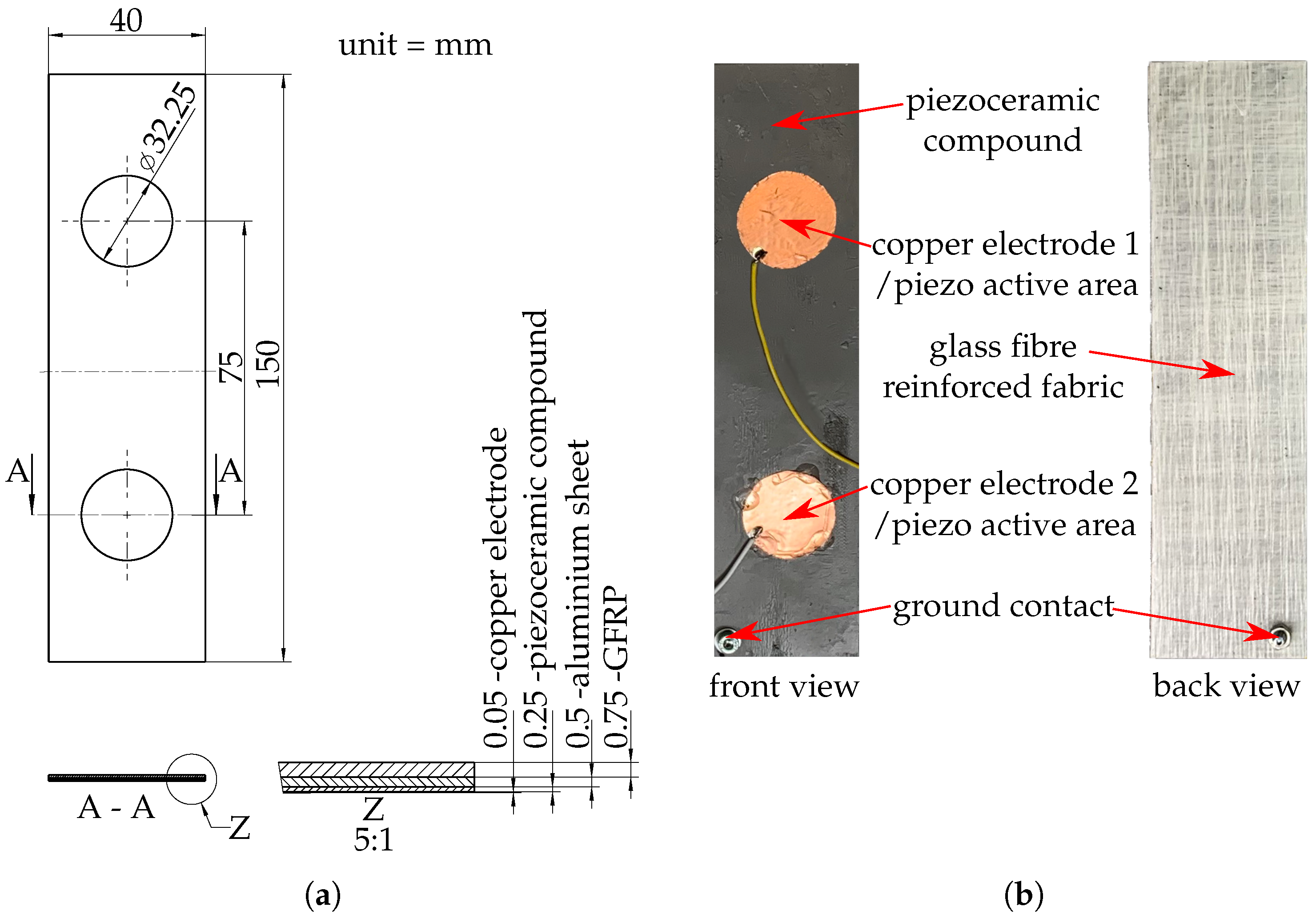
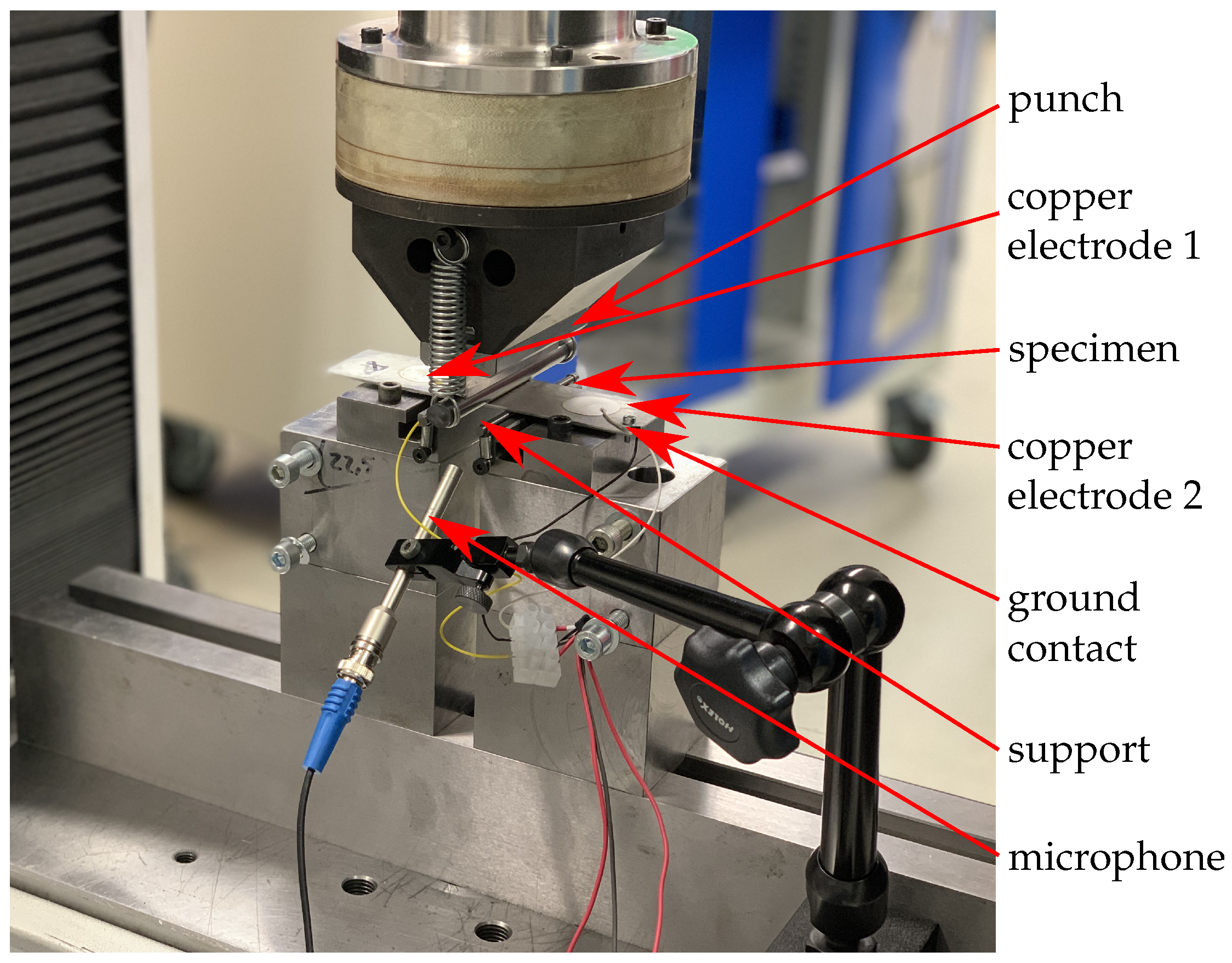
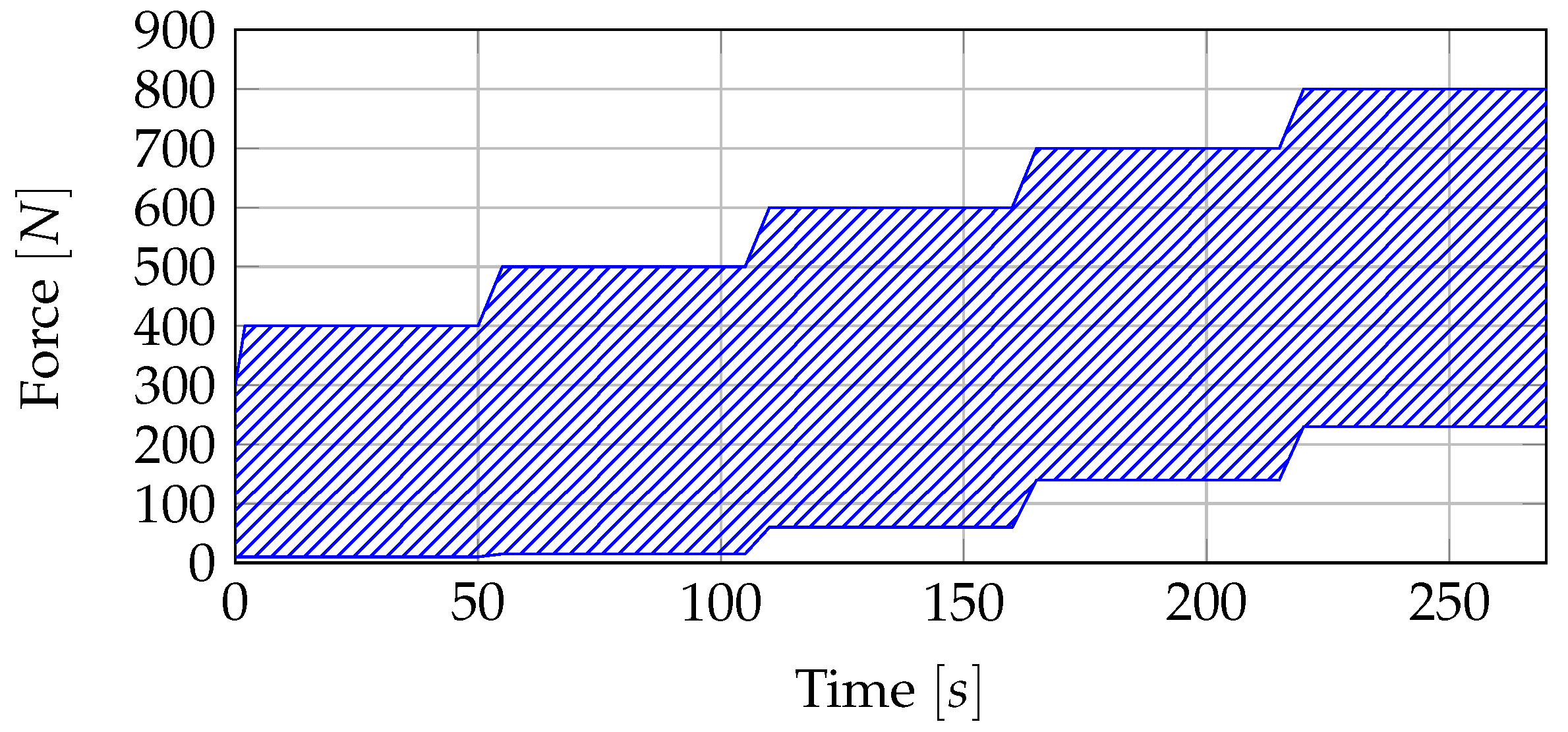
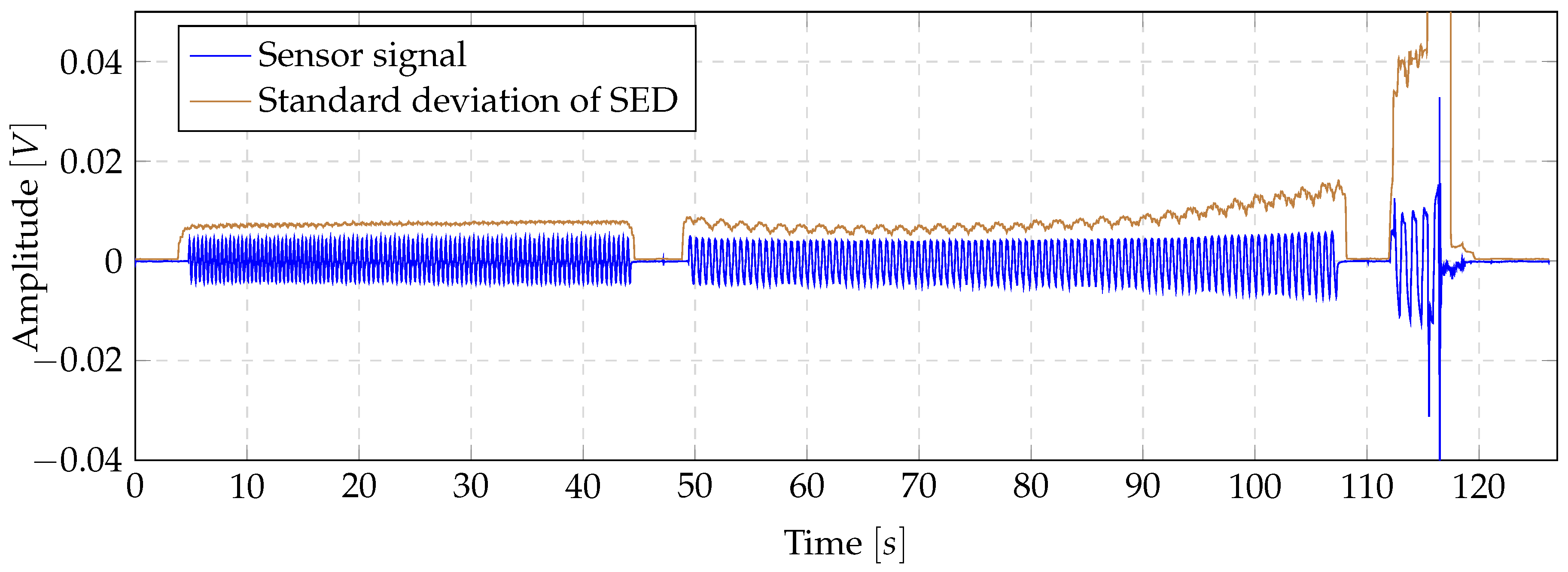
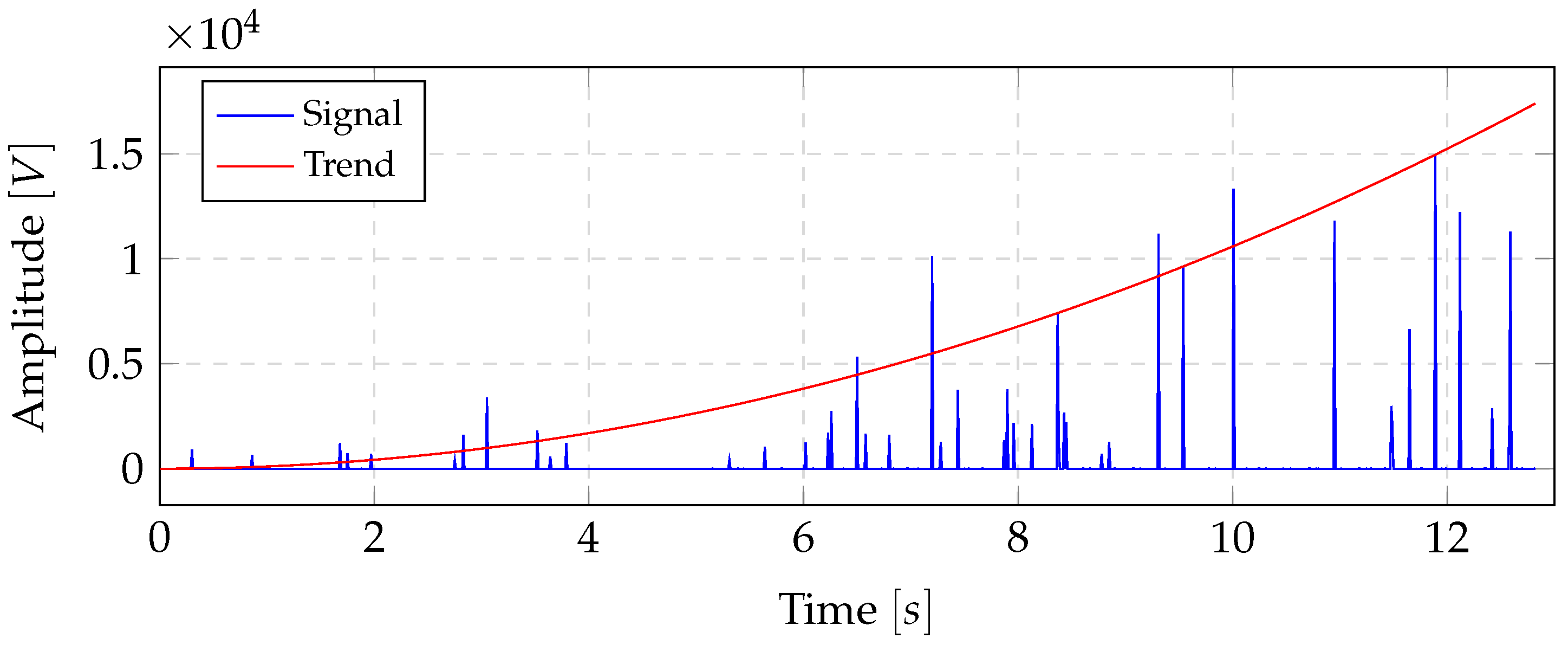
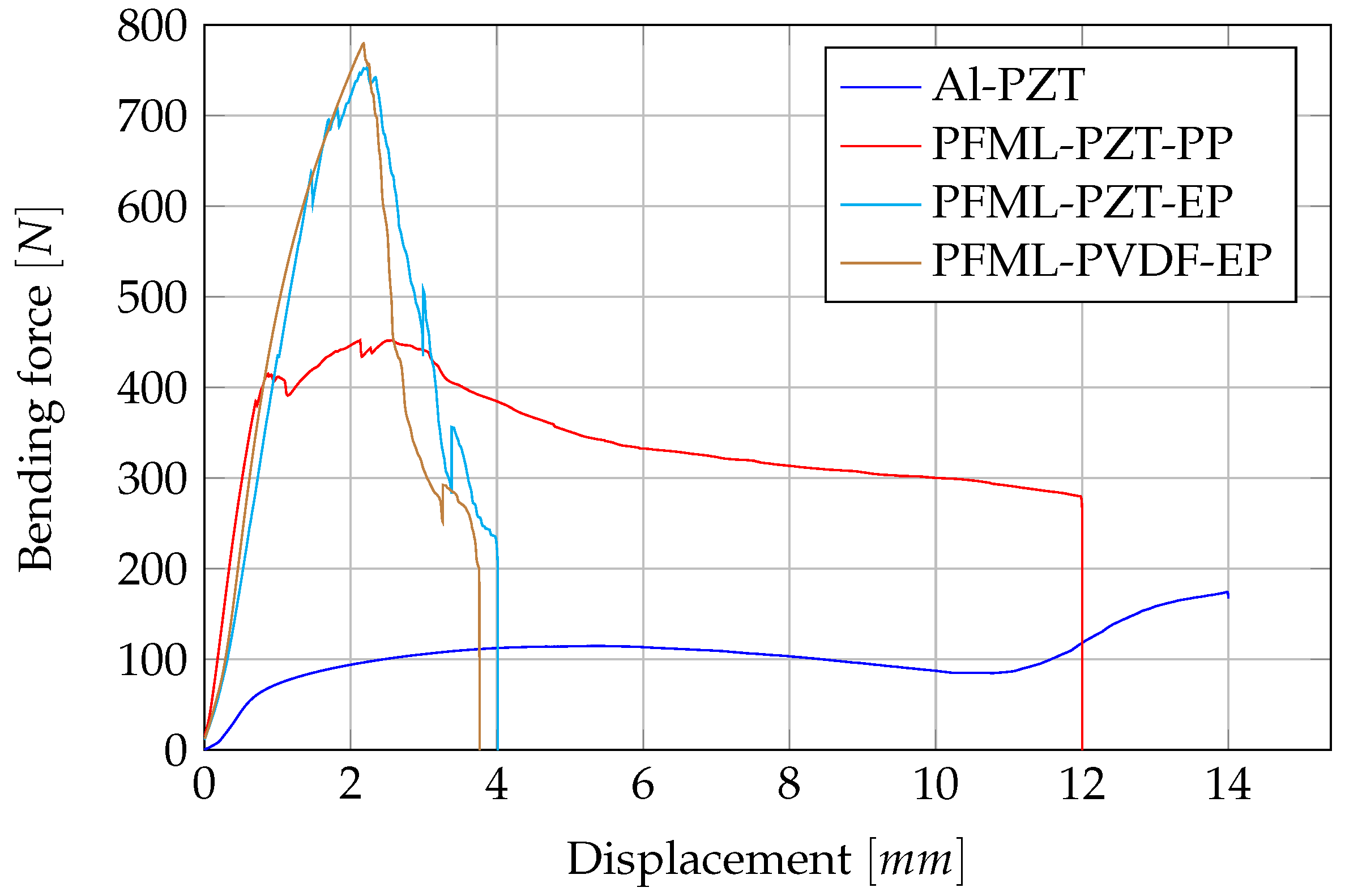
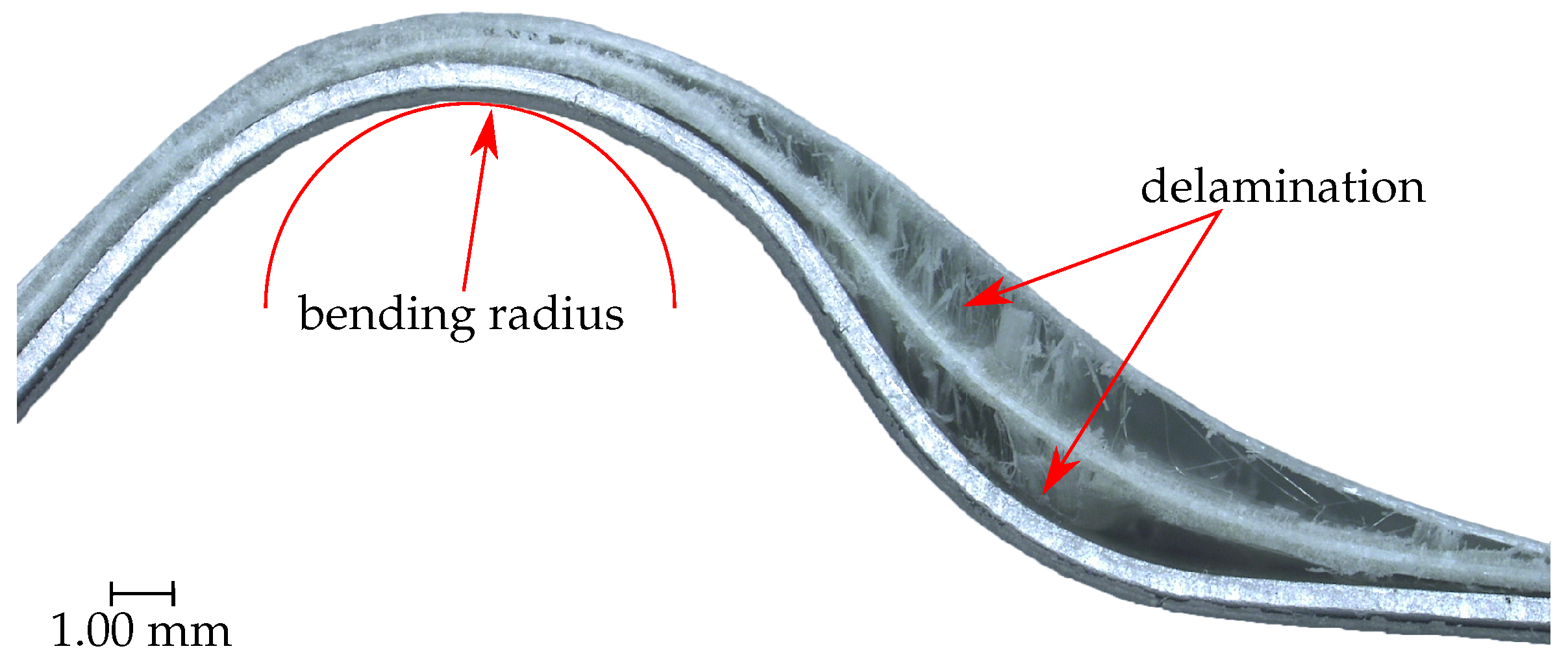
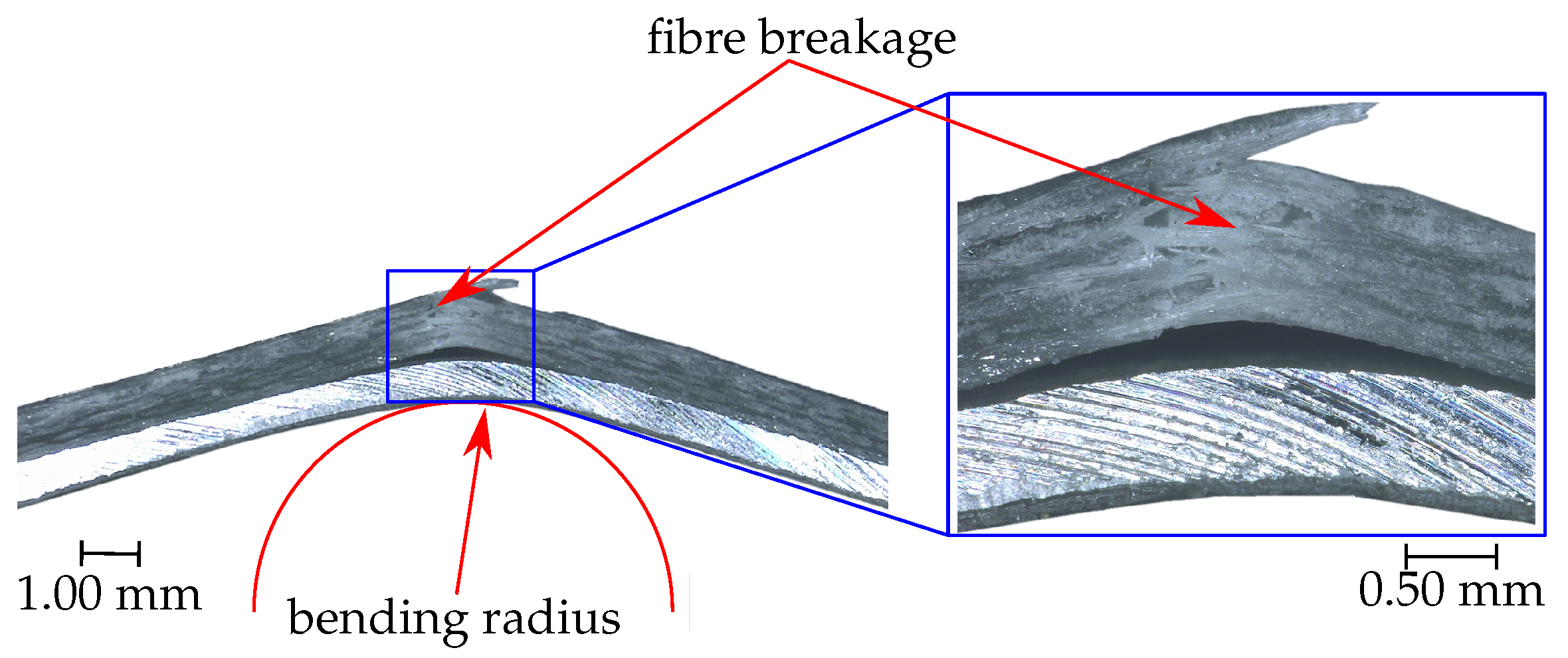
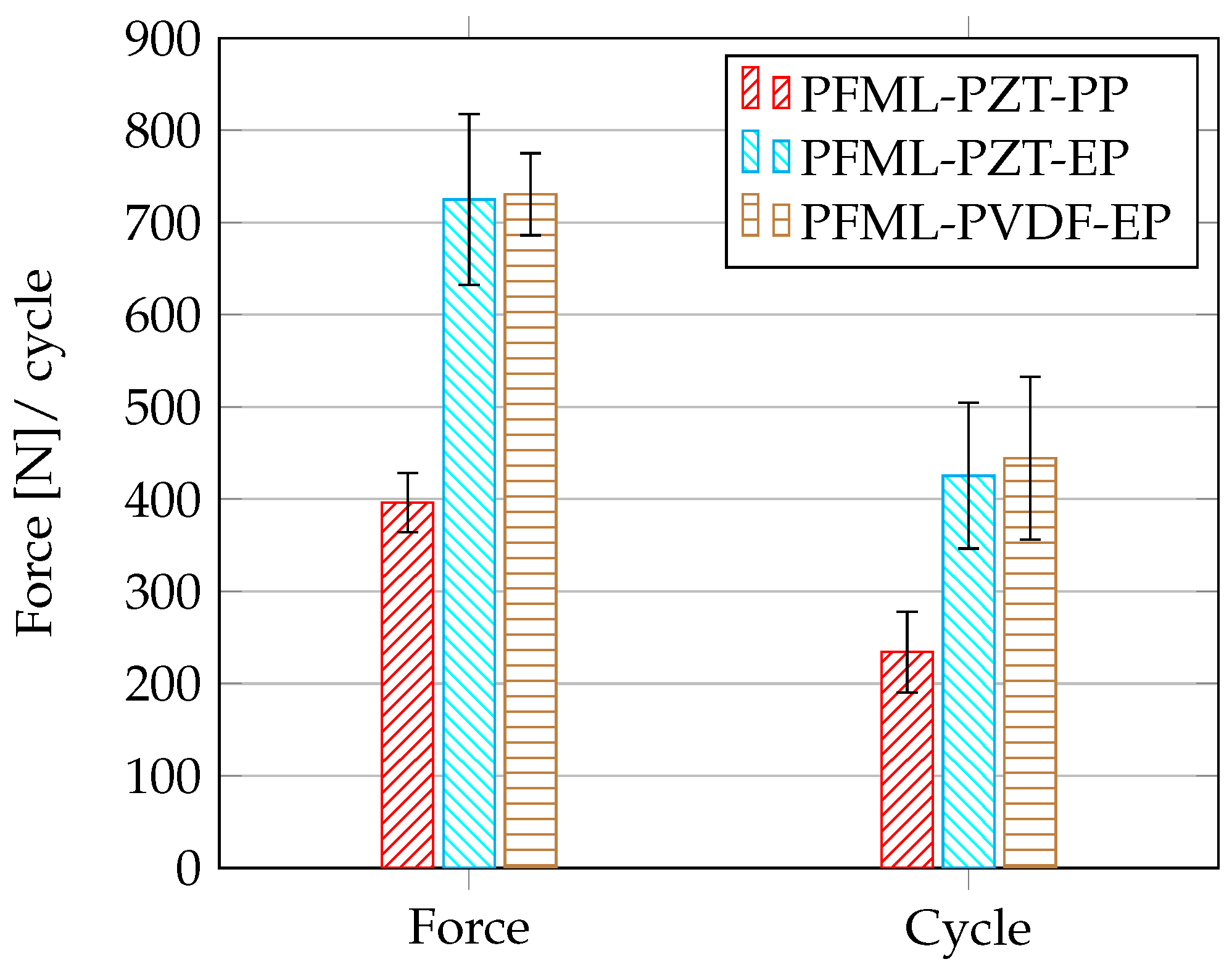
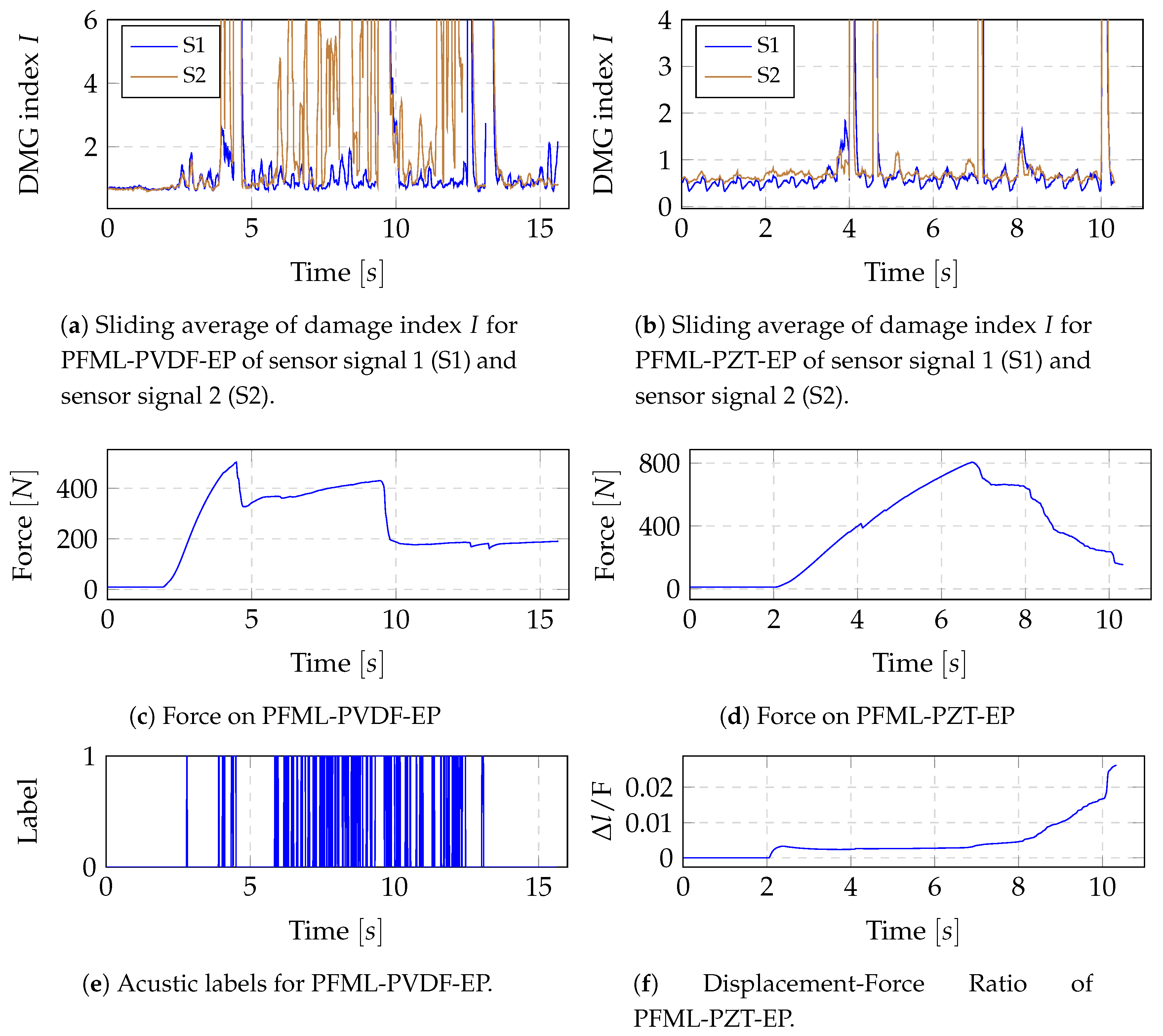
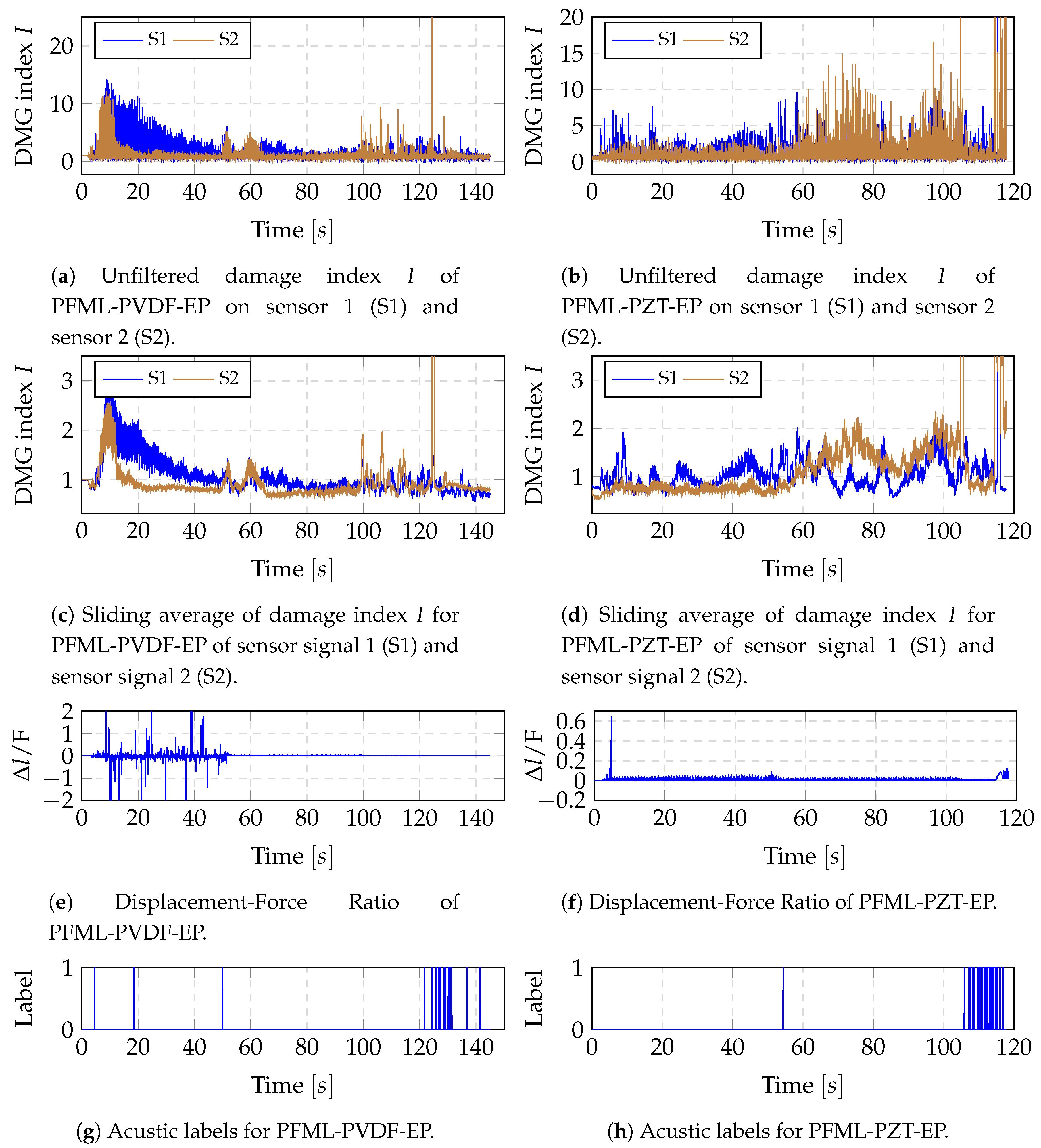
| Composite | Max. Force [N] | Bending Distance [mm] | Strengthening S | Ductility D |
|---|---|---|---|---|
| Al-PZT | 174.48 | 13.97 | 100% | 100% |
| PFML-PZT-PP | 452.12 | 12.00 | 259% | 86% |
| PFML-PZT-EP | 752.76 | 4.02 | 431.40% | 28.80% |
| PFML-PVDF-EP | 779.7 | 3.78 | 446.90% | 27.00% |
| Window Size in Samples | |||||||||
|---|---|---|---|---|---|---|---|---|---|
| Laminate | Method | 256 | 512 | 1024 | 2048 | 4096 | 8192 | 16,384 | 32,768 |
| PFML- PVDF-EP | STD-linear | 3 (100%) | 3 (100%) | 3 (100%) | 3 (100%) | 3 (100%) | 2 (66.6%) | - | - |
| STD-dB | 3 (100%) | 3 (100%) | 3 (100%) | 3 (100%) | 3 (100%) | 3 (100%) | - | - | |
| DMG | 3 (100%) | 3 (100%) | 3 (100%) | 3 (100%) | 3 (100%) | 3 (100%) | 3 (100%) | 2 (66.6%) | |
| PFML- PZT-EP | STD-linear | 2 (66.6%) | 2 (66.6%) | 2 (66.6%) | 2 (66.6%) | 2 (66.6%) | - | - | - |
| STD-dB | 2 (66.6%) | 2 (66.6%) | 2 (66.6%) | 3 (100%) | 3 (100%) | - | - | - | |
| DMG | 3 (100%) | 3 (100%) | 3 (100%) | 3 (100%) | 2 (66.6%) | 2 (66.6%) | 2 (66.6%) | 2 (66.6%) | |
| PFML- PZT-PP | STD-linear | 3 (100%) | 3 (100%) | 3 (100%) | 3 (100%) | 3 (100%) | 2 (66.6%) | 2 (66.6%) | - |
| STD-dB | - | - | 3 (100%) | 3 (100%) | 3 (100%) | 2 (66.6%) | 2 (66.6%) | - | |
| DMG | 3 (100%) | 3 (100%) | 3 (100%) | 3 (100%) | 2 (66.6%) | 2 (66.6%) | - | - | |
| Window Size in Samples | |||||||||
|---|---|---|---|---|---|---|---|---|---|
| Laminate | Method | 256 | 512 | 1024 | 2048 | 4096 | 8192 | 16,384 | 32,768 |
| PFML- PVDF-EP | STD-linear | - | - | - | 1 (33.3%) | 2 (66.6%) | 2 (66.6%) | - | - |
| STD-dB | - | - | - | 1 (33.3%) | 2 (66.6%) | 3 (100%) | - | - | |
| DMG | 2 (66.6%) | 1 (33.3%) | 3 (100%) | 3 (100%) | 2 (66.6%) | 3 (100%) | 3 (100%) | 1 (33.3%) | |
| PFML- PZT-EP | STD-linear | - | - | - | - | 1 (33.3%) | - | - | - |
| STD-dB | - | - | - | - | 1 (33.3%) | 1 (33.3%) | - | - | |
| DMG | 1 (33.3%) | 1 (33.3%) | 1 (33.3%) | 1 (33.3%) | 1 (33.3%) | 1 (33.3%) | - | - | |
| PFML- PZT-PP | STD-linear | - | - | - | - | - | - | - | - |
| STD-dB | - | - | 1 (33.3%) | 1 (33.3%) | 2 (66.6%) | 2 (66.6%) | 2 (66.6%) | - | |
| DMG | 2 (66.6%) | 3 (100%) | 2 (66.6%) | - | - | 1 (33.3%) | - | - | |
| Composites | Max. Force [N] | Max. Cycle |
|---|---|---|
| PFML-PZT-PP | 396.26 | 234 |
| PFML-PZT-EP | 774.51 | 472 |
| PFML-PVDF-EP | 730.67 | 444 |
| Window Size in Samples | |||||||||
|---|---|---|---|---|---|---|---|---|---|
| Laminate | Method | 256 | 512 | 1024 | 2048 | 4096 | 8192 | 16,384 | 32,768 |
| PFML- PVDF-EP | STD-linear | 5 (100%) | 5 (100%) | 5 (100%) | 5 (100%) | 5 (100%) | 5 (100%) | 5 (100%) | 4 (80%) |
| STD-dB | 5 (100%) | 5 (100%) | 5 (100%) | 5 (100%) | 5 (100%) | 5 (100%) | 5 (100%) | 4 (80%) | |
| DMG | 2 (40%) | 4 (80%) | 4 (80%) | 4 (80%) | 3 (60%) | 3 (60%) | 3 (60%) | 3 (60%) | |
| PFML- PZT-EP | STD-linear | 5 (100%) | 5 (100%) | 5 (100%) | 5 (100%) | 5 (100%) | 5 (100%) | 5 (100%) | 5 (100%) |
| STD-dB | 4 (80%) | 5 (100%) | 5 (100%) | 5 (100%) | 5 (100%) | 5 (100%) | 5 (100%) | 5 (100%) | |
| DMG | 5 (100%) | 5 (100%) | 5 (100%) | 5 (100%) | 5 (100%) | 5 (100%) | 5 (100%) | 5 (100%) | |
| PFML- PZT-PP | STD-linear | 4 (80%) | 4 (80%) | 4 (80%) | 4 (80%) | 4 (80%) | 4 (80%) | 4 (80%) | 4 (80%) |
| STD-dB | 1 (20%) | 3 (60%) | 3 (60%) | 2 (40%) | 2 (40%) | 3 (60%) | 3 (60%) | 3 (60%) | |
| DMG | 5 (100%) | 5 (100%) | 5 (100%) | 5 (100%) | 4 (80%) | 4 (80%) | 4 (80%) | 4 (80%) | |
| Window Size in Samples | |||||||||
|---|---|---|---|---|---|---|---|---|---|
| Laminate | Method | 256 | 512 | 1024 | 2048 | 4096 | 8192 | 16,384 | 32,768 |
| PFML- PVDF-EP | STD-linear | 1 (20%) | 1 (20%) | 1 (20%) | 2 (40%) | 2 (40%) | 2 (40%) | 2 (40%) | 2 (40%) |
| STD-dB | - | - | - | - | - | - | - | - | |
| DMG | 1 (20%) | 2 (40%) | 2 (40%) | 2 (40%) | 1 (20%) | 1 (20%) | 1 (20%) | - | |
| PFML- PZT-EP | STD-linear | - | - | 1 (20%) | 1 (20%) | 1 (20%) | 1 (20%) | 1 (20%) | 1 (20%) |
| STD-dB | - | - | - | - | - | - | - | - | |
| DMG | 2 (40%) | 2 (40%) | 2 (40%) | 2 (40%) | 2 (40%) | 2 (40%) | 2 (40%) | 2 (40%) | |
| PFML- PZT-PP | STD-linear | 2 (40%) | 2 (40%) | 2 (40%) | 3 (60%) | 4 (80%) | 4 (80%) | 4 (80%) | 5 (100%) |
| STD-dB | - | - | 1 (20%) | 1 (20%) | 1 (20%) | 1 (20%) | 2 (40%) | 3 (60%) | |
| DMG | 3 (60%) | 3 (60%) | 3 (60%) | 3 (60%) | 2 (40%) | 2 (40%) | 2 (40%) | 2 (40%) | |
© 2020 by the authors. Licensee MDPI, Basel, Switzerland. This article is an open access article distributed under the terms and conditions of the Creative Commons Attribution (CC BY) license (http://creativecommons.org/licenses/by/4.0/).
Share and Cite
Schmidt, R.; Graf, A.; Decker, R.; Heinrich, M.; Kräusel, V.; Kroll, L.; Hardt, W. Monitoring the Structural Health of Glass Fibre-Reinforced Hybrid Laminates Using Novel Piezoceramic Film. Sensors 2020, 20, 5428. https://doi.org/10.3390/s20185428
Schmidt R, Graf A, Decker R, Heinrich M, Kräusel V, Kroll L, Hardt W. Monitoring the Structural Health of Glass Fibre-Reinforced Hybrid Laminates Using Novel Piezoceramic Film. Sensors. 2020; 20(18):5428. https://doi.org/10.3390/s20185428
Chicago/Turabian StyleSchmidt, René, Alexander Graf, Ricardo Decker, Michael Heinrich, Verena Kräusel, Lothar Kroll, and Wolfram Hardt. 2020. "Monitoring the Structural Health of Glass Fibre-Reinforced Hybrid Laminates Using Novel Piezoceramic Film" Sensors 20, no. 18: 5428. https://doi.org/10.3390/s20185428
APA StyleSchmidt, R., Graf, A., Decker, R., Heinrich, M., Kräusel, V., Kroll, L., & Hardt, W. (2020). Monitoring the Structural Health of Glass Fibre-Reinforced Hybrid Laminates Using Novel Piezoceramic Film. Sensors, 20(18), 5428. https://doi.org/10.3390/s20185428





